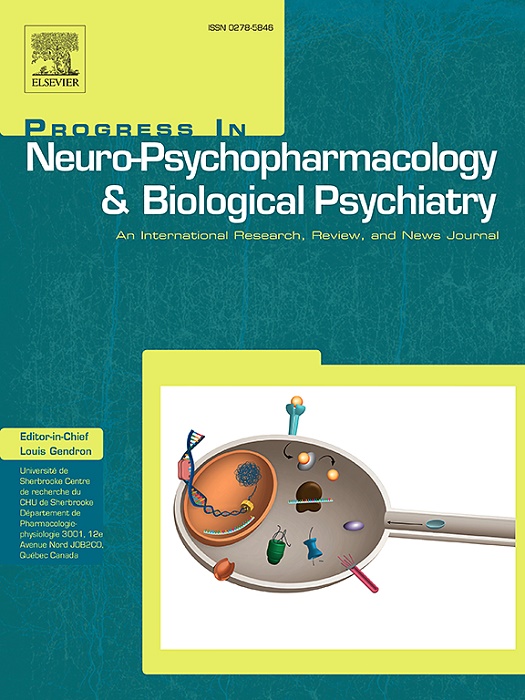Acoustic biomarkers for schizophrenia spectrum disorders and their associations with symptoms and cognitive functioning
IF 5.3
2区 医学
Q1 CLINICAL NEUROLOGY
Progress in Neuro-Psychopharmacology & Biological Psychiatry
Pub Date : 2025-03-20
DOI:10.1016/j.pnpbp.2025.111339
引用次数: 0
Abstract
Backgrounds
Acoustic biomarkers for schizophrenia spectrum disorders (SSDs) hold great promise due to their capacity to capture emotional information, which is often impaired in these patients. These biomarkers are easily accessible, noninvasive, objective, and cost-effective. This study investigated the accuracy of different machine learning (ML) models in classifying patients with SSDs or schizophrenia (SZ) versus healthy controls (HCs), as well as patients with cognitive-deficit (Cog-D) versus cognitive-non-deficit (Cog-ND) versus HCs. Additionally, correlations of the top 25 features contributing to these classifications with psychopathology and cognitive functioning were explored.
Methods
Speech data were collected from patients with SSDs (n = 238) and HCs (n = 157) using multiple tasks, including the reading of emotional sentences. The Extrapyramidal Symptom Rating Scale (ESRS) was used to control for potential medication effects on speech. Acoustic features were extracted using the openSMILE toolkit, and models were trained with 10-fold cross-validation. Partial correlation analysis, adjusted for ESRS and chlorpromazine (CPZ) equivalent, was conducted between the top 25 features and measures of psychopathology and cognitive functioning.
Results
Among the five ML models, accuracy of support vector machine (SVM) model was the best. It classified SSDs versus HCs with 83 % accuracy when using all 7 tasks, and 85 % when using only the happy sentences task. The SVM classification accuracy for Cog-D versus Cog-ND within SSDs was poor across all tasks; however, the accuracy for Cog-D versus HCs was 79 % when using free speech or happy sentences. The accuracy for classifying SZ versus HCs and Cog-D versus Cog-ND versus HCs exhibited variations. Several of the top 25 acoustic features correlated significantly with attention and verbal memory in patients with SSDs.
Conclusions
Our findings suggested that acoustic analysis, combined with a ML approach, could be used to classify successfully SSDs or the Cog-D subtype versus HCs. Features related to pitch, loudness, and timbre were particularly associated with attention in patients with SSDs. Future research should explore further the potential applications of acoustic biomarkers in multi-class classification, treatment response, and relapse detection in patients with SSDs.
精神分裂症谱系障碍的声学生物标志物及其与症状和认知功能的关联
精神分裂症谱系障碍(ssd)的声学生物标志物具有很大的前景,因为它们能够捕捉情绪信息,而这些信息在这些患者中经常受损。这些生物标记物易于获取、无创、客观且具有成本效益。本研究调查了不同机器学习(ML)模型对ssd或精神分裂症(SZ)患者与健康对照(hc)以及认知缺陷(Cog-D)患者与认知非缺陷(Cog-ND)患者与hc患者进行分类的准确性。此外,前25个特征有助于这些分类与精神病理和认知功能的相关性进行了探讨。方法对ssdd患者(238例)和HCs患者(157例)的语音数据进行多任务采集,包括情绪句的阅读。采用锥体外系症状评定量表(ESRS)控制药物对言语的潜在影响。使用openSMILE工具包提取声学特征,并使用10倍交叉验证训练模型。在ESRS和氯丙嗪(CPZ)当量校正后,对前25个特征与精神病理和认知功能测量进行偏相关分析。结果5种机器学习模型中,支持向量机(SVM)模型的准确率最高。在使用所有7个任务时,它对ssd和hc的分类准确率为83%,而在仅使用快乐句子任务时,准确率为85%。支持向量机对ssd内Cog-D和Cog-ND的分类精度在所有任务中都较差;然而,当使用自由言论或快乐句子时,Cog-D与hc的准确率为79%。SZ与hc、Cog-D与Cog-ND与hc的分类准确率存在差异。前25个声学特征中的几个与ssd患者的注意力和言语记忆显著相关。结论我们的研究结果表明,声学分析结合ML方法可以成功地对ssd或Cog-D亚型与hcc进行分类。与音高、响度和音色相关的特征与ssd患者的注意力特别相关。未来的研究应进一步探索声学生物标志物在ssd患者的多类别分类、治疗反应和复发检测中的潜在应用。
本文章由计算机程序翻译,如有差异,请以英文原文为准。
求助全文
约1分钟内获得全文
求助全文
来源期刊
CiteScore
12.00
自引率
1.80%
发文量
153
审稿时长
56 days
期刊介绍:
Progress in Neuro-Psychopharmacology & Biological Psychiatry is an international and multidisciplinary journal which aims to ensure the rapid publication of authoritative reviews and research papers dealing with experimental and clinical aspects of neuro-psychopharmacology and biological psychiatry. Issues of the journal are regularly devoted wholly in or in part to a topical subject.
Progress in Neuro-Psychopharmacology & Biological Psychiatry does not publish work on the actions of biological extracts unless the pharmacological active molecular substrate and/or specific receptor binding properties of the extract compounds are elucidated.

 求助内容:
求助内容: 应助结果提醒方式:
应助结果提醒方式:


